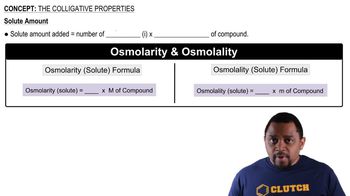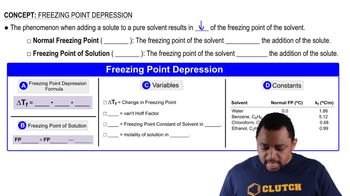Water softeners often replace calcium ions in hard water with sodium ions. Since sodium compounds are soluble, the presence of sodium ions in water does not cause the white, scaly residues caused by calcium ions. However, calcium is more beneficial to human health than sodium because calcium is a necessary part of the human diet, while high levels of sodium intake are linked to increases in blood pressure. The U.S. Food and Drug Administration (FDA) recommends that adults ingest less than 2.4 g of sodium per day. How many liters of softened water, containing a sodium concentration of 0.050% sodium by mass, would a person have to consume to exceed the FDA recommendation? (Assume a water density of 1.0 g/mL.)
Ch.14 - Solutions

Chapter 14, Problem 109
What is the freezing point of an aqueous solution that boils at 106.5 °C?
 Verified step by step guidance
Verified step by step guidance1
Identify the boiling point elevation formula: \( \Delta T_b = i \cdot K_b \cdot m \), where \( \Delta T_b \) is the boiling point elevation, \( i \) is the van't Hoff factor, \( K_b \) is the ebullioscopic constant, and \( m \) is the molality.
Calculate the boiling point elevation: \( \Delta T_b = 106.5 \, ^\circ\text{C} - 100 \, ^\circ\text{C} \).
Use the boiling point elevation to find the molality \( m \) of the solution: \( m = \frac{\Delta T_b}{i \cdot K_b} \). Assume \( i = 1 \) for a non-electrolyte unless specified otherwise.
Identify the freezing point depression formula: \( \Delta T_f = i \cdot K_f \cdot m \), where \( \Delta T_f \) is the freezing point depression and \( K_f \) is the cryoscopic constant.
Calculate the freezing point of the solution: \( T_f = 0 \, ^\circ\text{C} - \Delta T_f \).
Key Concepts
Here are the essential concepts you must grasp in order to answer the question correctly.
Colligative Properties
Colligative properties are physical properties of solutions that depend on the number of solute particles in a given amount of solvent, rather than the identity of the solute. These properties include boiling point elevation and freezing point depression, which are crucial for understanding how solutes affect the phase changes of solvents.
Recommended video:
Guided course

Colligative Properties
Boiling Point Elevation
Boiling point elevation occurs when a non-volatile solute is added to a solvent, resulting in an increase in the boiling point of the solution compared to the pure solvent. This phenomenon can be quantified using the formula ΔT_b = i * K_b * m, where ΔT_b is the boiling point elevation, i is the van 't Hoff factor, K_b is the ebullioscopic constant, and m is the molality of the solution.
Recommended video:
Guided course

Boiling Point Elevation
Freezing Point Depression
Freezing point depression is the decrease in the freezing point of a solvent when a solute is dissolved in it. Similar to boiling point elevation, it can be calculated using the formula ΔT_f = i * K_f * m, where ΔT_f is the freezing point depression, i is the van 't Hoff factor, K_f is the cryoscopic constant, and m is the molality of the solution. This concept is essential for determining the freezing point of the solution in the given question.
Recommended video:
Guided course

Freezing Point Depression
Related Practice
Textbook Question
Textbook Question
An isotonic solution contains 0.90% NaCl mass to volume. Calculate the percent mass to volume for isotonic solutions containing each solute at 25 °C. Assume a van't Hoff factor of 1.9 for all ionic solutes. a. KCl
Textbook Question
Magnesium citrate, Mg3(C6H5O7)2, belongs to a class of laxatives called hyperosmotics, which cause rapid emptying of the bowel. When a concentrated solution of magnesium citrate is consumed, it passes through the intestines, drawing water and promoting diarrhea, usually within 6 hours. Calculate the osmotic pressure of a magnesium citrate laxative solution containing 28.5 g of magnesium citrate in 235 mL of solution at 37 °C (approximate body temperature). Assume complete dissociation of the ionic compound.
